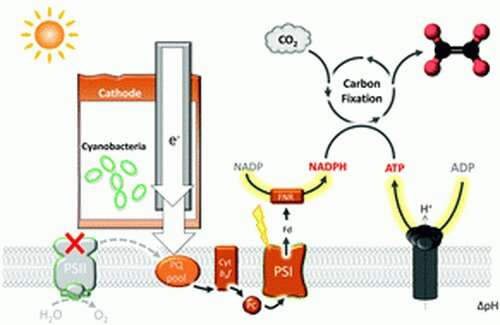September 28, 2021 report
Engineered cyanobacteria uses electricity to turn carbon dioxide into fuel

A combined team of researchers from the National Renewable Energy Laboratory and Miami University, has developed an engineering process that allows cyanobacteria to use electricity to turn carbon dioxide into ethylene or acetate. In their paper published in the journal Energy & Environmental Science, the group describes their technique and its possible use as an energy storage system.
As the researchers note, natural photosynthesis is an inefficient means for converting carbon dioxide to useful compounds for human purposes. In this new effort, the researchers have engineered part of the process to make it more efficient, and in so doing have developed a new way to store energy.
Scientists have divided natural photosynthesis into two main systems, photosystem I and photosystem II. Photosystem I involves the use of light to allow the transfer of electrons across a membrane. With photosystem II, enzymes capture photons that in turn energize electrons. The researchers noted that this system suffers from three main inefficiencies. The first is that the photosystems have overlapping absorption spectra. The second is that the oxygen produced by photosystem II has to compete with carbon dioxide for the enzyme that fixes the carbon pathway. And finally, natural photosynthesis can only use light in a limited part of the solar spectrum.
To overcome these inefficiencies, the researchers engineered cyanobacteria (a type of bacteria that obtain energy via photosynthesis, aka blue-green algae) in a way that allowed them to use sunlight and a stream of electrons to drive carbon dioxide fixation. More specifically, they removed all of photosystem II and replaced it with an artificial system that worked by attaching the modified cells to an electrical circuit. They found that when the cells were exposed to light, the cyanobacteria were able to deliver electrons to photosystem I, which allowed for converting carbon dioxide to useful fuels such as ethylene or acetate.
The researchers note that if a renewable resource was used as the source of the electricity, the system could be used as a means of energy storage. And, the greenhouse gas carbon dioxide could be used to produce greener fuels. More work is required, however, to find out how well the system could be scaled up to useful levels.
More information: Zhaodong Li et al, Exogenous electricity flowing through cyanobacterial photosystem I drives CO2 valorization with high energy efficiency, Energy & Environmental Science (2021). DOI: 10.1039/D1EE01526E
© 2021 Science X Network


















